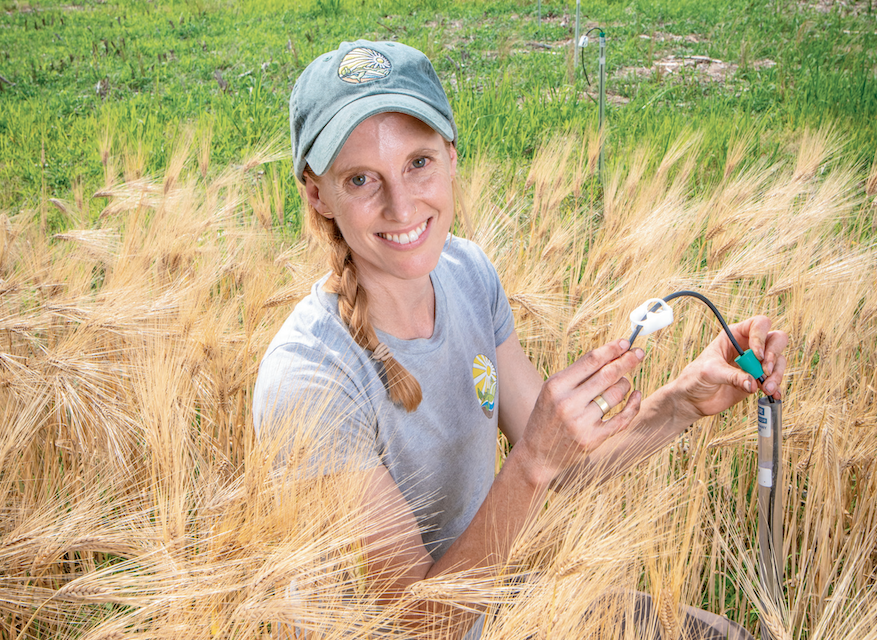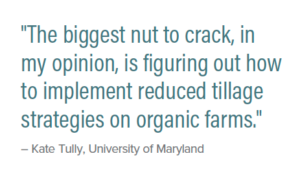
Dec 3, 2020
Dirt doctor Kate Tully says organic farming has a value for soil building
Kate Tully is an associate professor of agroecology in the Department of Plant Science and Landscape Architecture at the University of Maryland.
She holds a Ph.D. in ecology from the University of Virginia, and completed her post-doctoral fellowship at Columbia University’s Earth Institute. She recently joined Organic Grower for a conversation about her interest in organic agriculture, her research on soil health in organically-managed farms, and more.
Organic Grower: Can you share some information about your background, particularly as it relates to organic agriculture?
Kate Tully: I am an agroecologist and biogeochemist. As an agroecologist, I try to think about how to design agricultural systems such that they provide us with food (and feed, fiber and fuel) but also other important ecosystem services. For example, how can we grow corn such that it also recycles nutrients more efficiently and stores more carbon in the soil?
As a biogeochemist, my focus is on nutrient cycling – that is, understanding the fate of fertilizers (organic or inorganic). I also try to design management strategies to store more carbon in our agricultural systems (for example, no-till, adding organic amendments, planting buffer strips, etc.).
I am specifically interested in organic agricultural systems because they are fundamentally more biologically diverse systems that rely on internal nutrient cycling (as opposed to the external application of nutrients characteristic of conventional farming). Organic growers are innovative and always willing to experiment with a new practice that might help their bottom line and mother nature.
OG: Based on your education, research and your own personal experience, how would you define a healthy soil?
KT: I define a healthy soil as one that can provide a multitude of ecosystem functions, such as storing carbon, cycling nutrients and water, and of course, growing food! I moonlight as an organic farmer myself, and I run an urban community farm called Columbia Heights Green in northwest Washington, D.C., along with my partner. We are not certified organic, but we manage the farm organically. We grow vegetables, fruit trees, berries, flowers and herbs. At the farm, we plant cover crops each winter to feed the soil. We also make our own compost from food scraps neighbors drop off. It’s so neat to grow a pumpkin, watch the skins come back to the compost pile and then return to the soil. Nothing makes me happier.
OG: Last December, you published an in-depth research review with Cullen McAskill on soil health in organically-managed farming systems in the journal “Organic Agriculture.” What led you to conduct that research review?
KT: I was interested in improving my understanding of which management practices that are available to organic farmers can improve soil health. A lot of past research compared conventional farming to organic farming. To me, that is comparing apples to oranges, and it also assumes that the only difference between them is the source of fertilizer (or feed). But there are many subtle differences between organic and conventional farms and between various organic farms as well. So, I set out to examine only those research studies that compared organic farms to other organic farms in an effort to figure out if some management practices provide a bigger bang for their buck than others.
OG: In that research review, you discovered a number of interesting findings, which you also discuss in an Organic Center report you co-authored with Jessica Shade. Could you share the main takeaways?
KT: The report I wrote with Jessica Shade summarized the findings of that 2019 study very well, so I will quote directly from there. My co-author Cullen McAskill and I “conducted a global systematic review of … studies that compared practices within organic farming systems to report soil health indicators.” We found that “four key practices emerged as being the most critical for impacting soil health, including: cover crops, organic amendments, rotation diversity and length, and tillage.”
 We discovered “there is an abundance of studies showing that cover crops enhance soil health overall, but there is sparse research comparing how cover crops [affect] soil health in organic systems. While this paucity of data clouded trends that may be apparent, it was clear that roll-killed cover crops [suppress] weeds better than disking.”
We discovered “there is an abundance of studies showing that cover crops enhance soil health overall, but there is sparse research comparing how cover crops [affect] soil health in organic systems. While this paucity of data clouded trends that may be apparent, it was clear that roll-killed cover crops [suppress] weeds better than disking.”
In terms of organic amendments, our research review found that “combining different organic amendments (such as vermicomposts in combination with manure) is better for soil health than using one type of organic fertilizer alone.”
Our review also found that “diversity in rotations was key to enhancing soil health, especially when it comes to including perennials, such as alfalfa, into the systems to improve soil health indicators including soil carbon, nitrogen and aggregate stability.”
Finally, the studies we reviewed showed “that reducing tillage can increase soil carbon, but the variable definition of ‘reduced tillage’ [made] it difficult to identify other potential trends. Unfortunately, organic no-till methods can decrease yields, so future research should focus on ways to reduce tillage without having a negative impact on yield. Alternately, shallow non-inversion tillage (also called ‘vertical tillage’ or ‘strip-tillage’) can optimize both yields and soil carbon storage.”
For more on my research review with McAskill, I would encourage readers to check out our published study in the journal “Organic Agriculture” and the Organic Center report I co-wrote with Jessica Shade (available on the Organic Center website, https://organic-center.org/).
OG: You noted that no-till methods have been shown to lead to reduced yields. What is it about no-till that causes the yield reduction?
KT: The primary reason that no-till in organic systems can lead to yield reduction is because tillage is a key way to kill weeds. In conventional systems, farmers use multiple herbicide applications as their primary way to kill weeds. Coming up with multi-tactic approaches to killing weeds (e.g., planting cover crops that release weed-suppressing chemicals) in organic systems in combination with reduced tillage (rather than no-till) approaches will help to improve soil health overall.
OG: What are some highly effective but underutilized soil health practices/growing techniques that you think should be employed more often by organic farmers?
KT: The biggest nut to crack, in my opinion, is figuring out how to implement reduced tillage strategies on organic farms. Mixed crop-livestock systems can also enhance soil health by reintegrating livestock (which produce lots of manure) with crops (which use manure).
OG: You’ve focused a lot of your research on cover crops. Can you share a bit about your work in that area?
KT: My cover crop research focuses on how we can manage cover crops to improve agroecosystem services. That is, let’s think about cover crops as a CROP! How can we utilize them to effectively cycle nutrients, store water and stabilize carbon in our soils? If cover crops are actively managed for the services they provide, we can optimize them to help increase both cash crop productivity but also environmental and soil health.
OG: Another one of your areas of specialization is agroforestry. What are some ways organic farmers can use agroforestry principles to improve their operations? In your opinion, is agroforestry underutilized in organic farming (and farming in general) in the U.S.?
KT: Agroforestry, in its most simple definition is, “trees on farms.” There are lots of ways that organic farmers could think about incorporating more trees into their operations. Trees can be grown to provide many different services, for example, new sources of income (e.g., fruit, nut, and timber trees), which can make the operation more resilient to market changes. Trees can be incorporated within the field (if equipment permits) as an alley crop or on the edge of a field as a windbreak. Trees can also be grown to provide shade for animals or be a source of mulch to the main crop.
Many organic growers are already tree farmers (e.g., growing fruit trees), but that doesn’t mean they are practicing agroforestry, which involves planting trees with crops. For example, tree farmers can consider alley cropping, where you plant crops that are high-value and shade tolerant like turmeric or ginger. Overall, agroforestry is underutilized in the U.S. in organic and conventional agriculture. Trees can provide a suite of agroecosystem benefits to both the farmer and the environment.
OG: You’ve spent significant time studying abroad – in Costa Rica, Kenya and Tanzania. Have any of those international experiences influenced how you think about organic farming and growing methods?
KT: My first experience with organic farming was in college when I lived and worked on an organic orange and mango farm in Costa Rica. I then began researching organic and conventional coffee agroforestry systems. I remember how a common term for pesticide among the organic farmers in Costa Rica was “veneno” or poison. They never called them agrochemicals or tried to soften the meaning.
If you have ever lived in the tropics, you know that there is always a constant thrum of sound – there is always a bird, an insect, a frog. I distinctly remember the day I visited one of the conventional banana plantations in the Central Valley because we walked into the farm, and it was silent. The bananas were covered in plastic and nothing made a noise except the swish of machetes as a stalk was cut down to retrieve the fruit. To me, organic agriculture is noisy – it is a system full of life and full of sound.
OG: Is there anything else you’d like to share related to organic agriculture? In all your years researching and practicing organic ag, is there anything you’ve found that really surprised you?
KT: I think my story about the silent banana farm was my big “ah-ha” moment when I realized the importance of organic agriculture for supporting ecosystem health. In addition, I love that I get to research organic farming while being an organic farmer myself. It is great fun to take something that I learned in my research and use it to make my own farm more productive!
Above, Kate Tully is associate professor of agroecology in the Department of Plant Science and Landscape Architecture at the University of Maryland. Photo: Edwin Remsberg






